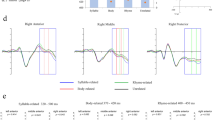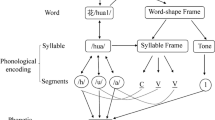Abstract
Empirical evidence for a functional role of syllables in visual word processing is abundant, however it remains rather heterogeneous. The present study aims to further specify the role of syllables and the cognitive accessibility of syllabic information in word processing. The first experiment compared performance across naming and lexical decision tasks by manipulating the number of syllables in words and non-words. Results showed a syllable number effect in both the naming task and the lexical decision task. The second experiment introduced a stimulus set consisting of isolated syllabic and non-syllabic trigrams. Syllable frequency was manipulated in a naming and in a decision task requiring participants to decide on the syllabic status of letter strings. Results showed faster responses for syllables than for non-syllables in both tasks. Syllable frequency effects were observed in the decision task. In summary, the results from these manipulations of different types of syllable information confirm an important role of syllabic units in both recognition and production.
Similar content being viewed by others
References
Aichert I., Ziegler W. (2004). Syllable frequency and syllable structure in apraxia of speech. Brain and Language 88, 148–159
Aichert I., Ziegler W. (2005). Is there a need to control for sublexical frequencies?. Brain and Language 95, 170–171
Ans B., Carbonnel S., Valdois S. (1998). A connectionist multiple-trace memory model for polysyllabic word reading. Psychological Review 105, 678–723
Baayen, R. H., Piepenbrock, R., & van Rijn, H. (1993). The CELEX Lexical Database (CD-ROM). Philadelphia, PA: Linguistic Data Consortium, University of Pennsylvania.
Bachoud-Levy A.-C., Dupoux E., Cohen L., Mehler J. (1998). Where is the length effect? A cross-linguistic study of speech production. Journal of Memory and Language 39: 331–346
Baddeley A.I. (2003). Working memory and language: An overview. Journal of Communication Disorders 36(3): 189–208
Barber H., Vergara M., Carreiras M. (2004). Syllable-frequency effects in visual word recognition: Evidence from ERPs. Neuroreport 15, 545–548
Carreiras M., Álvarez C.J., de Vega M. (1993). Syllable frequency and visual word recognition in Spanish. Journal of Memory and Language 32, 766–780
Carreiras M., Perea M. (2004a). Naming pseudowords in Spanish: Effects of syllable frequency. Brain and Language 90, 393–400
Carreiras M., Perea M. (2004b). Effects of syllable neighbourhood frequency in visual word recognition and reading: Cross-task comparisons. In: Ferrand L., Grainger J.(eds) Psycholinguistique cognitive. Bruxelles, Belgium: De Broeck Université
Cholin J., Levelt W.J.M., Schiller N. (2006). Effects ofsyllable frequency in speech production. Cognition 99(2): 205–235
Coltheart M., Rastle K., Perry C., Langdon R., Ziegler J. (2001). DRC: A dual route cascaded model of visual word recognition and reading aloud. Psychological Review 108(1): 204–256
Conrad M., Jacobs A.M. (2004). Replicating syllable-frequency effects in Spanish in German: One more challenge to computational models of visual word recognition. Language and Cognitive Processes 19(3): 369–390
Eriksen C., Pollack M., Montague W. (1970). Implicit speech: Mechanism in perceptual encoding?. Journal of Experimental Psychology 84: 502–507
Ferrand L., New B. (2003). Syllabic length effects in visual word recognition and naming. Acta Psychologica 113, 167–183
Ferrand L., Segui J. (2003). Reading aloud polysyllabic words. In: Assink E.M.H., Sandra D.(eds) Reading complex words: Cross language studies. New York, Kluwer Academic, pp. 295–314
Ferrand L., Segui J., Grainger J. (1996). Masked priming of words and picture naming: The role of syllabic units. Journal of Memory and Language 35: 708–723
Forster K.I., Chambers S. (1973). Lexical access and naming time. Journal of Verbal Learning and Verbal Behavior 12, 627–635
Grainger J., Jacobs A.M. (1994). A dual-read out model of word context effects in letter perception: Further investigations of the word superiority effect. Journal of Experimental Psychology: Human Perception and Performance 20: 1158–1176
Hofmann, M., Stenneken, P., Conrad, M., & Jacobs, A. M. (2006). Sublexical frequency measures for orthographic and phonological units in German. Behavior Research Methods, accepted for publication.
Hutzler F., Bergmann J., Conrad M., Kronbichler M., Stenneken P., Jacobs A.M. (2004). Inhibitory effects of first syllable-frequency in lexical decision: An event-related potential study. Neuroscience Letters 372(3): 179–184
Hutzler F., Conrad M., Jacobs A.M. (2005). Effects of syllable-frequency in lexical decision and naming: An eye movement study. Brain and Language 92, 138–152
Jacobs A.M., Graf R., Kinder A. (2003). Receiver operating characteristics in the lexical decision task: Evidence for a simple signal-detection process simulated by the multiple read-out model. Journal of Experimental Psychology: Learning, Memory, & Cognition. 29(3): 481–488
Jared D., Seidenberg M.S. (1990). Naming multisyllabic words. Journal of Experimental Psychology: Human Perception and Performance 16(1): 92–105
Klapp S.T. (1971). Implicit speech inferred from response latencies in same-different decisions. Journal of Experimental Psychology 91, 262–267
Klapp S.T., Anderson W.G., Berrian R.W. (1973). Implicit speech in reading, reconsidered. Journal of Experimental Psychology 100, 368–374
Kwantes P.J., Mewhort D.J.K. (1999). Modeling lexical decision and word naming as a retrieval process. Canadian Journal of Experimental Psychology 53(4): 306–315
Laganaro M. (2005). Syllable frequency effect in speech production: evidence from aphasia. Journal of Neurolinguistics 18, 221–235
Lee C.H. (2001). Absence of syllable effects: Monosyllabic words are easier than multisyllabic words. Perceptual and Motor Skills 93, 73–77
Levelt W.J.M., Wheeldon L. (1994). Do speakers have access to a mental syllabary?. Cognition 50: 239–269
Massaro D.W., Cohen M. (1994). Visual, orthographic, phonological, and lexical influences in reading. Journal of Experimental Psychology: Human Perception and Performance 20: 1107–1128
Mathey S., Zagar D. (2002). Lexical similarity in visual word recognition: The effect of syllabic neighborhood in French. Current Psychology Letters: Behavior, Brain and Cognition 8: 107–121
Perea M., Carreiras M. (1998). Effects of syllable frequency and syllable neighborhood frequency in visual word recognition. Journal of Experimental Psychology: Human Perception and Performance 24(1): 134–144
Prinzmetal W., Treiman R., Rho S.H. (1986). How to see a reading unit. Journal of_ Memory and Language 25: 461–475
Rapp B.C. (1992). The nature of sublexical orthographic organisation. The bigram trough hypothesis examined. Journal of Memory and Language 31: 33–53
Rey A., Ziegler J.C., Jacobs A.M. (2000). Graphemes are perceptual reading units. Cognition 75, B1–B12
Rodrigo López M., Jiménez González J.E. (2000). IQ versus phonological recoding skill in explaining differences between poor readers and normal readers in word recognition: Evidence from a naming task. Reading and Writing: An Interdisciplinary Journal 12: 129–142
Roelofs, A. (2002). Syllable structure effect turn out to be word length effects: Comment on Santiago et al. (2000). Language and Cognitive Processes 17(1): 1–13
Rubin D.C. (1974). The subjective estimation of relative syllable frequency. Perception and Psychophysics 16(1): 193–196
Santiago J., MacKay D.G., Palma A. (2002). Length effects turn out to be syllable structure effects: Response to Roelofs (2002). Language and Cognitive Processes 17(1): 15–29
Santiago J., MacKay D.G., Palma A., Rho C. (2000). Sequential activation processes in producing words and syllables: Evidence from picture naming. Language and_ Cognitive Processes 15(1): 1–44
Schiller N. (1998). The effect of visually masked syllable primes on the naming latencies of words and pictures. Journal of Memory and Language 39: 484–507
Schiller N.O. (2000). Single word production in English: The role of subsyllabic units during phonological encoding. Journal of Experimental Psychology: Learning, Memory, and Cognition 26: 512–528
Seidenberg, M. S. (1987). Sublexical structures in visual word recognition: Access units or orthographic redundancy? In M. Coltheart (Ed.), Attention and performance XII: The psychology of reading (pp. 244–263). Hillsdale, NJ: Erlbaum.
Spoehr K.T., Smith E.E. (1973). The role of syllables in perceptual processing. Cognitive Psychology 5: 71–89
Stenneken P., Conrad M., Goldenberg G., Jacobs A. (2003). Visual processing of sublexical units in dyslexia. Brain and Language 87: 137–138
Stenneken P., Conrad M., Hutzler F., Braun M., Jacobs A.M. (2005). Frequency effects with visual words and syllables in a dyslexic reader. Behavioural Neurology 16, 1–15
Stenneken P., Hofmann M., Jacobs A.M. (2005). Patterns of phoneme and syllable frequency in jargon aphasia. Brain and Language 95: 221–222
Wheeldon L.R., Levelt W.J.M. (1995). Monitoring the time course of phonological encoding. Journal of Memory and Language 34: 311–334
Ziegler W. (2005). A nonlinear model of word length effects in apraxia of speech. Cognitive Neuropsychology 22: 603–623
Ziegler J.C., Perry C., Coltheart M. (2000). The DRC model of visual word recognition and reading aloud: An extension to German. European Journal of Cognitive Psychology 12: 413–430
Zorzi M., Houghton G., Butterworth B. (1998). Two routes or one in reading aloud? A connectionist dual-process model. Journal of Experimental Psychology: Human Perception and Performance 24: 1131–1161
Author information
Authors and Affiliations
Corresponding author
Rights and permissions
About this article
Cite this article
Stenneken, P., Conrad, M. & Jacobs, A.M. Processing of Syllables in Production and Recognition Tasks. J Psycholinguist Res 36, 65–78 (2007). https://doi.org/10.1007/s10936-006-9033-8
Published:
Issue Date:
DOI: https://doi.org/10.1007/s10936-006-9033-8




